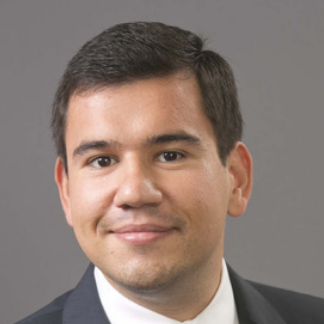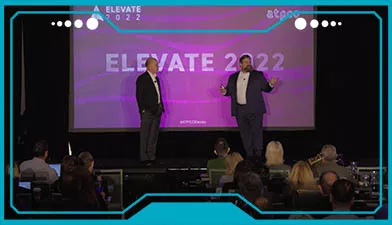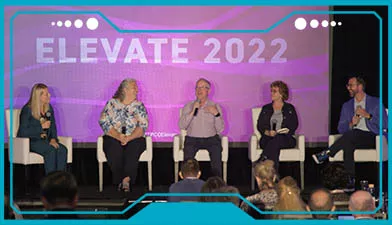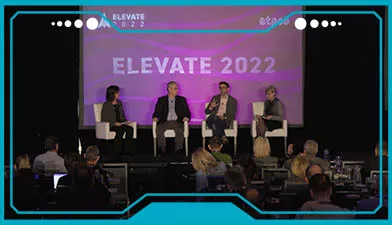On demand | Elevate 2022
The state of the industry: ATPCO, T2RL, and McKinsey weigh in
KEYNOTE • DYNAMIC OFFER CREATION
Dynamic offer creation is a hot topic right now, and for good reason! The potential is practically limitless, but are we getting to the finish line quickly enough? How do we sprint ahead with innovation?
Join the race with this great stage-setting discussion among ATPCO and two industry players.
Tom: Good morning, everyone. You end the day with me. You start the day with me. Isn't every day just a great day?
I'm Tom Gregorson, chief strategy officer, ATPCO. I'm going to give a little bit of an update on the state of the industry. Starting out, the industry's been talking about NDC for over 10 years now. We actually donated the Open AXIS schema as the baseline version in 2010. So a long, long time we did the NDC and now dynamic offers. We started that in earnest in 2018, so we're five years now going into it and moving that forward.
So where are we on the path to transformation? We all are talking about it, our colleagues here have actually published reports on where the industry's at and sharing. So T2RL is saying basically from a dynamic offers and dynamic pricing, in their May report, they're saying availability is the only dynamic capability currently in place for the vast majority of the airlines. So we're still on a opening and closing of buckets. On their NDC report, they're saying IATA estimates that about 10% of NDC for indirect bookings, they actually came up and tried to extrapolate that to how many millions of bookings that would be and their estimate is a little bit less than that. So they're saying it's somewhere in between. But we're still at the early, early adoption of NDC.
And then we worked with McKinsey back in 2018 and created this matrix of capabilities on dynamic offers. And we really looked at the different ways, and we'll talk about this a little bit more on the X axis on how prices can evolve and the dynamic offers from filing of fares to adjusting of fares to continuous pricing and how the Y axis, the up axis, is the variation in product. You have set products, you'd offer some options, you offer some fare families and brands, and you go to a fully dynamic offer and we call that optimized offers, adjusted offers, and continuous offers. When we started the journey, McKinsey estimated for us it was going to be about a $40 billion incremental lift in the industry if we really achieve dynamic offers, so a lot of value. So where are we at with that?
We asked McKinsey to do an update for us. That was back in 2018. When we originally started our journey, the view was that we would grow the dynamic offers as an overall composite and the optimized offers, the blue on the bottom would have less of a presence of the overall area. So in 2018 is the top of what was the forecast at that time. We were about a $550 billion industry, 90% or so was really done through traditional optimized offer mechanisms and the forecast was by 2023 we'd be at 30% dynamic offers, 70% of optimized, and 2028, 10% of the optimized and 90% of dynamic.
Well, we asked them to do an update and they took a projection based on COVID and based on kind of the airlines’ ability to invest and we're not there. 2023 right now it looks like we'll still be 90% of the availability, the pricing and the optimization, and only 10% dynamic offers and 2028 will still be at 70/30x is what they're projecting. So we're moving slower than we thought.
So we thought we'd share with you what we're seeing on our database for the 400 plus airlines that we do business with. And Alex mentioned a little bit in the morning yesterday. On the fares database, the number of active fares in the marketplace, we've actually seen a growth in our database. We're now over 300 million which is the red bars, 300 million active fares on the database at any one time in the marketplace and we kind of overlaid that with ASK. So basically even as schedules dropped off, fare volume continues, which means you have four more fares per flight than ever before.
And on the rate of change, we see the actual average number of changes we're seeing on a daily basis continue to go up. In 2018, we did about 2 million changes on the database each and every day. Now we're over 12 million changes. So it's really growing, the number of changes that are happening in the marketplace, and seeing. At the same time, we saw growth in optional services and branded.
So what we've done is we actually tried to profile each and every airline, not just doing an aggregate level. You're seeing out of those 400 airlines what is the airline composition look like and trying to come up with an index of how we are moving along in our modern airline retailing. So the index is here. So in 2018 what we had as a composition, you'll see those numbers are actually number of airlines and we took and said OK, who's got just fares with baggage data, which is the lower left column, so it has a bundled product with fares and bags. And then who has low churn in the very first column, high churn in the middle column, using dual RBD to get more transactions in the third column. And then in 2022, you'll see actually including the continuous pricing. And on the Y axis. who's got just fares and bags? Who's got optional services, who has fare families, just three, who has more than three fare families as the brands.
And we plotted all the carriers and it's interesting to see that in 2018 we were really an airline industry that was very heavily weighted to the lower left. 227 airlines had just regular fares, not a lot of churn and low turnover. And by 2022 we're seeing that actually what has happened is we got actually more diversity in the product. So then you have more than just fares and bags. We got more optional services, more airlines are doing brands, and we're seeing that the growth in their churn is actually going. So they're actually going up a paradigm where we're seeing more fare churn and then they go to dual RBD to get actually more fare product churn and then including continuous pricing.
So we see that we're at a road of maturity and we created an index. We said in 2018 we would have been about a 2.0 if you thought about capabilities. So if under kind of the diagonal axis, we would plot it right there. By 2022, we moved it up a little bit, about 3.8 as far as the index. But we still have a long, long way to go in dynamic offers. So that sets the context of where we're at. And I would say this is something we're going to commit to doing each and every year. It's giving you an update on where the state of the industry is using hard data because I think it's important for us to understand where we all are at so we know how to invest properly and move forward together.
One last question, one last thing I'm going to say is, I really think it's important to remember I'm a father of four, and I have four kids and they're all completely different. And I think this is how the industry should look at it. All of these guys are all going to be different. We're all going to land in a different spot of capability on the matrix, which is great because we all don't want to be the same. But we want to give each and every one of my kids the same opportunities. So we want to create and unlock the capabilities so they can pick their path and pick wherever they want in that spot.
So with that, I'm going to go into the panel and start opening with questions and comments on where do we think we are. First question. I did the introduction, I showed where we're at. This was a huge value proposition and was going to be $40 billion for the industry in order to create value to it. Do we think the value is still there? Is this something worth chasing and is it still there high value for us to actually go explore? Now I'll start with Alex, you set this goal of 2026 for us to get to 80%.
Alex: Well, obviously, yes. I've cheated a little bit to be honest with you. So, many don't know, but I came from the hotel industry and at my time at Hyatt, I was there and we actually built a revenue management system that transitioned the company from basically a simplex revenue management system to a dynamic and continuous pricing system. And we saw exactly what this did inside of the organization. In that particular industry they measure by Rev Par Index which is how am I doing against my competitive set, and it drove almost two percentage points of differentiation between us and our competitors despite the fact that our competitors like Marriott were 7 to 10 times our size. So our ability to really get good at that became a huge differentiator.
The other thing I'll say is as we started to go into offers, it really turned into a win-win. We measured the NPS, which is customer satisfaction. And what we saw was when customers were choosing those offers because now they got, a base room plus other things. And typically for the hotel, the average stay now increased in price. So they got more money per stay, but the average cost for all those ancillaries went down for the consumer. So the consumer was actually happier. This is one of those times where there's a very rare win-win where the customer can get exactly what they want and it ends up with more profit and more revenue for the supplier. So, yes.
Tom: Yes. Giacomo, 40 billion, you said back in 2018, and saying this is what the industry value is. Is it still there? Is the value still you have to be unlocked?
Giacomo: Absolutely. I think 40 billion is absolutely still there and I think that's probably even a conservative number. I think it is important to point out as Alex said, it truly is one of the few instances where we have a win-win between consumers and passengers being able to get more value for their money and being targeted exactly with what's relevant to them. And airlines being able to better segment and improve profitability.
Now I will say the 40 billion is meant to be a end state, steady state, once we're in the top right. I do want to make sure that we understand that there will be a lot of incremental value and I think actually the trajectory of how we get there is probably equally important as the final destination of the 40 billion. And so during that transition as we saw in your page earlier, we've already saw in the last four years of broadening and a widening of the gap between some of the more advanced or some more mature, I should say, retailers versus some that are a little bit behind. So I think as time progresses I do think that that distance will eventually increase, which presents both challenges because as you mentioned at the end we have to work together and there's you know interlining and partnership considerations that will have to work together across partners and we may have one partner at a different level of maturity in the other, but it also presents some competitive opportunities as well.
I mean let's not forget in some competitive head-to-head battles, you may be in a situation where one airline actually has more granular pricing and more dynamic offer generation than its competitors. So I think that would be, it's been many years since the industry has had some sort of differentiation like that. 15 years ago in the RM systems, you'd see some of the players that had maybe a network system versus leg based and I think this actually has the potential to increase that strategic distance even more. So I think it will be exciting to see how that plays out.
Tom: Mr. Clarke, you talk about value all the time and cost in the industry. What do you think about the value of dynamic offers?
Richard: Yes. So we don't need to debate it anymore. We just need to get on with it. I think that's the key, is how we get on with it, is the most important. What I'm most concerned about is suppliers pricing out the benefit prematurely, creating more costs than we should be taking on, and that's really our, T2RL's, primary concern. So that's where we see some of the challenges. But yes, the size of the prize is there. We need to go for it and we need to get on with it, which is why it's great to see ATPCO change the focus of their mission and great job.
Tom: Yeah, good. So value can be different by party. Will there be winners and losers in this transformation and how do we think that that's going to evolve? Richard, do you want to talk a little bit of that? I think you talked a little bit on the transformation and cost.
Richard: Yeah, for sure. Are we going to show a slide? So could I ask Amadeus people not to take a picture of this? If you like this slide, you have to promise to take the slide with the slide that comes with it and present them together, not one of them because it suits you to do so.
So 1.277 is not a benchmark. It's not what you should be achieving. It's not a goal. It's to try and understand that there's a stack of costs and when we put in a sophisticated revenue management system. For those of you that build them, you understand that the organization that supports something that's complex and forecasting O&D and so on costs a lot more than a simple leg-seg system. OK, so the idea here is to show the stack of costs as they are today in proportion. So that's not an Amadeus person there with a camera. Take them out, security. That's what the Prime Minister said in the UK. So this, this is supposed to be representative of the proportions of how we end up when we look at the total cost, and this is on a per-passenger basis, and you could say this is about a 30 million passenger carrier.
If you go to the next slide, Tom, this is the most important slide. 1.277 goes to 1.115, releasing about 14% of benefit to do what? To fund the transition over six or seven years, and if you apply 1.5% inflation to the 1.277 in year two and you accumulate that, and you take the 1.115 and you take inflation at 1.5%, the delta will give you enough money to fund the transition. Now this includes NDC. This includes shopping. This includes the APIs you need to get the job done. And it also includes a premium for DCS. Why? Because the delivery system that doesn't exist today, which needs to exist tomorrow, rather an interface to a delivery system has to come into being and it will be more expensive than the ones we have today. DCS is pretty good value today for what we pay for it, given the importance in operations. So for me, the funding of the transition is critical. And if the vendors are too greedy on the way in, we've got a problem. If the vendors aren't greedy enough on the way out, we have a problem. So we have to start to think about this in the totality.
And every single airline will have a different path to implementing this bit by bit. Some of the smarter airlines have chosen to focus on offer and make that offer available through the existing channels. Obviously NDC is an important part of that, but the reality is they're able to get some dynamic offers onto their websites. How many of you have full content agreements with your GDSs? Hands up. None of you, fantastic. You can do whatever you want, right, as long as you keep parity and you manage that. So there's a great opportunity here and there is a way to fund it. That's because we go from here to here and those people that fund it better by thinking through the implementation, they're the winners. Those people that put a box on top, another box on top, retire nothing. They're the losers. And that goes for the vendors as well, by the way.
So that's how we see the problem and that's how we have to think about it together. And to come to ATPCO and watch them tell you guys, hey we're here for the journey, we're going to help you out. We can help you in the short term but we can also help you in the long term. I think that's absolutely fantastic and I stood up on stage here in 2019 and said the first thing you should all do is sign up for NDC Exchange. Now you've got a ton of code that you can all use, actually you don't need to talk to the vendors as much as you did before because you can come and talk to ATPCO. How's that?
Tom: Very good, very good support. Thank you for the nice comments. But I like your comments also that there's value here that can be achieved and delivered and extracted and grow because you can go from 1.277 to 1.115. So there's money there in order to fund the transition. Giacomo, any other comments on value and winners and losers?
Giacomo: I think I touched on the winners losers earlier a little bit. I think it does represent an opportunity for the industry to create a competitive advantage for those airlines that do get some distance and move further up on the right ahead of others. I think on the cost side, is definitely important and I think it's a way to fund it.
What gets me even more excited, at least for me personally as a revenue side, and I think we've heard yesterday from Air Canada, I think of how they started small and started slowly making some small wins to fund that that journey and I think what we're seeing from chief commercial officers is they're asking questions on how can they build that business case and what is the right ambition level. Should they start referencing the 40 billion and trying to get funding for a three-year journey, should they start small? And I think, as much as I support our $40 billion, if I were CFO I think I'd want to see more than a McKinsey report to fund that.
And so I think to us the key to moving fast is starting small, start on the website, start proving value very quickly, again starting from the commercial revenue improvement mindset versus an IT implementation project and very quickly demonstrate to the business that this brings incremental revenue.
Tom: Excellent. I'm going to jump to the next one and maybe start with you, Alex again. So why do we think it's going slow? What's really the barriers that's really preventing us to move faster?
Alex: I'm going to juxtapose this. So in some ways it's not going slow. When you look at your number 2 to 3.8 doesn't look like a big number when you're just saying, boy, that's only 1.8. But that's almost a doubling of complexity when you think about the carriers. The number of carriers that are in that bottom left box got reduced by half. So that's not so bad.
It's when you start to jump off, one of the issues that that's really clear to me is there has not been a clear roadmap on how you get through this. You know you can't go from that bottom left box all the way to dynamic pricing. The institutional knowledge and the capability within the organization won't know how to actually satisfy that. So in some ways you kind of need to go through that maturity matrix.
And for us, it's, I'm going to put some of the onus back on ATPCO. We have existing customers that are already paying us money and we should be out there saying, you know, you only file once a week. Here's a set of tools that allow you to see what your competitors are up to that let you file in a more automated way. So now you can file once a day. Oh, you're filing once a day? Here's some ancillaries you can start to add so that you look more competitive. Oh, you have ancillaries and filing once a day? Here are some fare families you can start to do. So I think part of it is on us. To really help our customer base really take advantage of everything that's already available, so that when it comes time to kind of jump off the historical ATPCO capability and now you're using some of the things we just announced yesterday, your entire organization is ready and you can actually fulfill on the promise for your customers and your organization on those things. So for me, we really got to focus. You know, it's always easy to focus on the guys at the very end on the right, but we really have to focus on the entire industry and make sure that there's a clear path for people all the way to the top.
Tom: Thanks, Alex. You're actually helping me do my job as the strategy officer. I can talk to my boss and he can tell me what we need to do and it helps make sure our strategy is aligned. Richard, do you have any thoughts on how going slow and what's the barriers?
Richard: And I think Jerry eloquently put that there's a people issue and I think we have a people issue. And if you look at what happened during COVID, those people that know, retired. And those that people that think they know, are not in this room. So we have a people issue, but we have some constraints in the industry from just the history.
And I think one of the problems is it looks like such a big problem that there are very few people that have been able to plot their way through the process and think it out. If Lufthansa are here in the room. They've been thinking about this for a very, very, very long time and have made good progress on the offer side that puts them in a position to know how they want the orders to be structured and what they need to do. And I think Jerry and British Airways in the same sort of position. Air France, KLM, they've been thinking about this problem for a long time and they have an approach to it.
So I think we have a people issue and obviously you don't have a procurement issue because you can hire us. But the reality is we have to have some people that understand how, the size of the prize, no discussion. How we get there and how we map that out, how do we prove value each step of the way, that is something that is much harder and much more difficult. But you know, we're in the right place to do something about it, right?
Tom: Giacomo, McKinsey works with a lot of airlines. What are your thoughts on pace of going and how we actually can, is it going too slow on the barriers and how do you move it forward faster?
Giacomo: Too slow, it's a little bit relative. I think you know in general dynamic offers it's hard. This represents, dynamic offer represents the top right of the ambition, not just in airline retailing but in retailing in any vertical. I mean if we look at ecommerce or other areas where we typically think that they are ahead of airlines, even then today there there's very few if any retailers that are consistently offering dynamic. offers at the time of shopping generation. So let's be sort of honest and say this is, this truly is challenging and it is difficult and it will be a journey sort of getting there throughout the evolution path, and that's why I think we have to remember, let's see what can we do right away and what are the actions we can do to drive value right away.
Air Canada again gave a great example yesterday. I was going to say on stage that today if I go on almost any airline website and I search for a flight to Atlanta one person, day trip to New York, one passenger, one adult, same day return versus I search two adults, two children for a 7-day stay on Saturday in Orlando for example. I see in almost all airlines the exact same booking path throughout the entire website. And even though we probably can assume that they're likely have different purpose of travel, and so this does not require an AI, does not require hyper- personalization, does not require cookies, does not require personal profiles. It requires starting small and going after the money and doing what you can even on your own website. So I think the journey has many starting points, we all look at the final end state in the top right, but I think there's a lot of money to be made looking at what we can do right away.
Tom: So we talked about going slow and how we pick up the pace, try it, try things out and evolve them. Are there, do you all have an idea of what would really expedite and make us all get there faster?
Richard: Well, yes, a plan. We need a plan and each airline needs a slightly different plan. They have revenue accounting systems, they have revenue management systems, they have PSS coming up for contract. Each one of those airlines has to think through the term dates of those contracts and build their plan. But I think actually the good thing is that we know where we're going, that's a good start and there are different steps and I think Giacomo is absolutely spot on. We can take some small steps, prove out the value and prove to management, to the skeptics, I would say because that's their job, how we get there. So I think that's, I think people should be making a plan.
And obviously we're very happy to help out on the procurement side because you'll be accurate revenue management system before you procure revenue accounting system. You still have to have real world compatibility and you have to think through some of those problems.
And I think we at our conference last week we talked about delivery, delivery has been completely underestimated. Right. We need to think that through a bit and we need to think through the airport operations side of things because we're already complex. We already, disruption nearly kills us all. I took 9 1/2 hours to get here. I won't name the airline, but 9 1/2 hours from Toronto, it was a bit, that's a bit too much at the end of the day. So we need to deal with that. And if I'd had five products instead of two, it might have been a disaster.
So I think we need to manage that through, but we need a plan and we need to get on with it. We need to get on with it. Famously, the Queen of England said, what do you do if you're faced with this? “Just get on with it,” she said. And that's what we need to do. Stop talking. Let's get on with it.
Tom: I'm going to go to Alex next. I mean, we have the 80% by 2026. The projections aren't there like we said. So it's not where are we tracking to? It's really what can we do to accelerate. Do you have some thoughts there?
Alex: Yeah, I have two that are pretty simple. First is there is a set of capabilities that's going to be necessary for airlines to really start jumping off ATPCO and I think part of it is we have to start to enable some of those things in a more realistic way.
The second is if you're doing it today, you showed 11 airlines that were doing what we would call adjustments. Those airlines have settled in either one or two things, they built it all themselves or they have agreed to do a proprietary technology lock in with a customer because there's no standards. Once you get off of that, the standards are gone. What I have seen in every industry that I have ever been in, and this is especially true on the technology side, when you start to build standards, it starts to make everything go faster because more companies come in more capability, it makes customers feel more comfortable because they can switch if things aren't working out. It isn't the commitment that it is when you start to build homegrown or you start to commit to a proprietary solution. So we really need to think about what that ecosystem is going to look like to really allow the industry to flourish.
Tom: Giacomo, do you have any other comments on this?
Giacomo: I think couldn't agree more on the plan. I think we get called from a lot of airlines asking you to review the plans or ask them to help make the plans. And what we've seen is sometimes going a little too ambitious and too large, the plans collapse on their way and if we look at the current environment, getting large funding for multi-year projects is going to become probably increasingly difficult in the next few years. And so I think start with a very modular, small plan, set revenue targets versus technology targets, and advance in a very go fast and fail early. So I think what we heard about from Air Canada yesterday I think was encouraging and I think if next year we're sitting here and we're hearing not one airline but ten airlines that that made small steps forward made some mistakes, because if we're not making any mistakes we're probably not moving fast enough, as long as we're not making the same ones, and get on with it.
Tom: Okay, I'm going to try it again. This time we'll see what we do. One sentence, one word, one takeaway. Well, if you want to leave the audience with one thing that they should do and saying what does success look like here for 2023? If we're sitting on the stage, what would you say that would be?
Richard: I go first?
Tom: You can go first.
Richard: Work with ATPCO. Right now. That's it.
Tom: Thank you.
Richard: And T2RL.
Giacomo: Follow the money.
Alex: Trial. Try something. If you're in the bottom left box, try something up. Try something over. Just start the process. One foot forward.
Tom: I think they actually play them back the other way. Try. You'll get some money. Working with us is a way to get there.
Thank you very much. We actually have a panel coming up next talking about what we're doing in the Councils and standards and all that. So you will continue to have that discussion of how we actually enable this capability.
Thank you very much for all the great colleagues here.
An event experience you can't miss
ATPCO's Elevate + ARC's TravelConnect
Speakers

Tom Gregorson
Chief Strategy Officer, ATPCO
For over 25 years, Tom has been working to develop products that enhance the travel industry. Throughout his career, he has gained insight and provided leadership through his various roles at airlines and global distribution systems, and with ATPCO since 1996. In his current role, Tom leads the Strategy organization and is responsible for creating the long-term vision for ATPCO and exploring new business ventures. His focus is on industry standards and effective ecosystem governance, as well as driving forward concepts like dynamic pricing and tax automation. Tom has built a reputation for being a thought leader and implementer of industry solutions in the distribution space.

Alex Zoghlin
President and CEO, ATPCO
A lifelong entrepreneur and innovator, Alex brings more than 25 years of knowledge and experience in technology, airline distribution, and travel to ATPCO. He founded six startups, including Orbitz and G2Switchworks, before serving as Executive Vice President, Global Head of Strategy, Innovation, and Technology at Hyatt Hotels Corporation. He brings his business acumen and experiences from the hospitality world to concepts the airline industry can use, such as addressing digital booking flows, digital display, unstructured datasets, and dynamic pricing. When not working, Alex enjoys spending time with his wife and four daughters, making music, building rockets, and learning new things.

Richard Clarke
Co-CEO, T2RL
Richard’s 30-plus years of experience in the travel industry includes work as a consultant and an adviser on technology selection and contracting for airlines, global distribution systems, travel agents, governmental agencies, regulatory bodies, institutional investors, and IT system vendors. Richard’s focus has always been on data-driven decision-making. Richard has lived in the UK, France, Spain, Thailand, China, and Canada. He has a BA in Business Finance and Accounting from Coventry Business School in the UK.

Giacomo Palombo
Partner, Atlanta, McKinsey & Company
Giacomo is a core leader in McKinsey’s Airline Practice and has led McKinsey’s Pricing and Revenue Management Service Line globally for the travel and transportation sectors since 2018. For the past 9 years, Giacomo has been working exclusively with travel, transport, and logistics clients, serving over 20 airlines, hotels, and rail operators across four continents. Previously, he spent 10 years working as a charter, corporate, and airline pilot. Giacomo holds MBA and MS in Transportation Engineering degrees from the University of California, Berkeley, as well as a Bachelor of Science (BSc) degrees in Aerospace and Atmospheric Sciences. He is a certified airline pilot and flight instructor with over 6,000 hours of flight time. In his free time, Giacomo enjoys camping, hiking, concerts, traveling, and flying acrobatics.
You might also like



